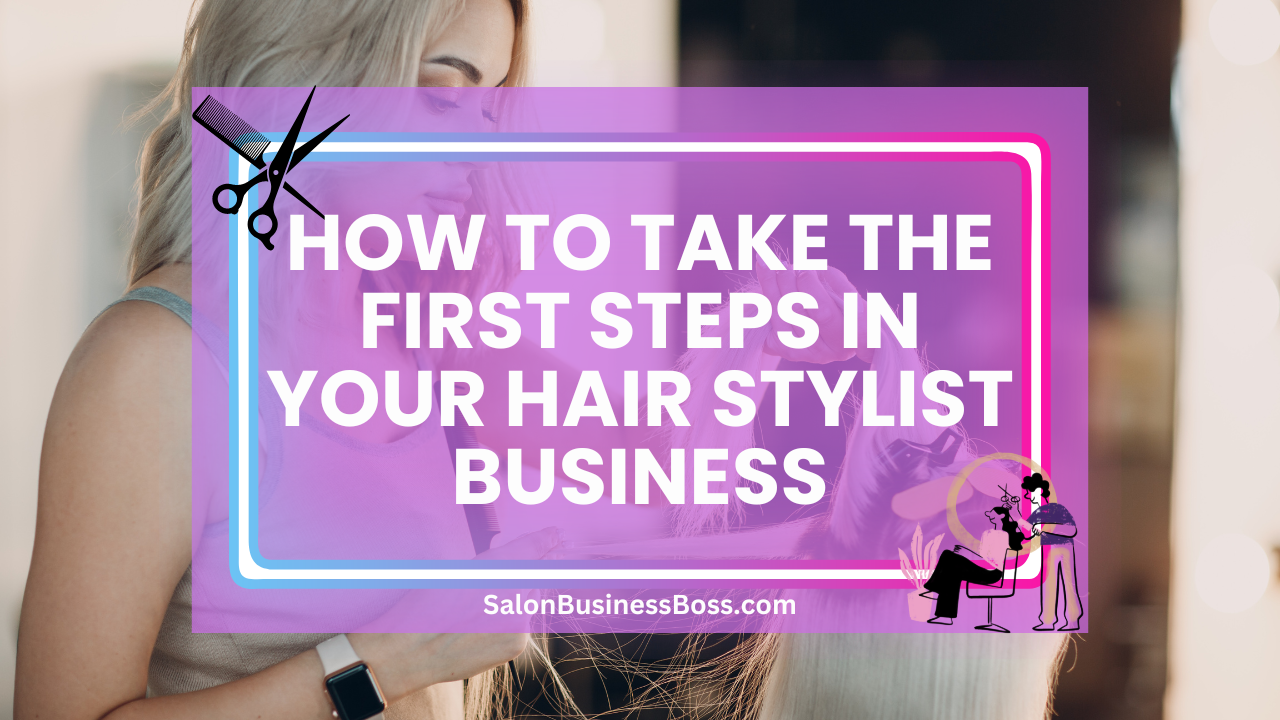Starting a hair stylist business can be an exciting and rewarding venture for those passionate about haircare, fashion, and creativity. However, like any business endeavor, it requires careful planning, dedication, and a clear vision to succeed.
To start a hair stylist business, define your concept, create a business plan, and obtain the necessary licenses. Set up an inviting salon space, invest in quality equipment, and build a talented team. Craft a strong brand identity, implement a marketing strategy, and offer exceptional customer service to thrive in the competitive industry. Monitor progress, adapt, and stay dedicated to your vision for a rewarding journey.
1. Define Your Business Concept
Defining your business concept is a crucial initial step in starting a hair stylist business. Take the time to envision the unique identity you want your salon to have. Consider the range of hair services you will offer, such as haircuts, coloring, styling, extensions, or specialized treatments. Analyze the market demand and assess what sets you apart from other hair stylists in your area.
Understanding your target market is equally vital. Decide whether you want to cater to specific demographics, like men, women, children, or individuals with particular hair types. Tailoring your services to meet the needs and preferences of your target audience will help attract a loyal clientele.
Developing a unique selling proposition (USP) is a key element of defining your business concept. Your USP highlights the distinctive features that differentiate your salon from competitors. This could include exceptional customer service, eco-friendly products, specialized expertise, or innovative hair treatments. A compelling USP will resonate with potential customers and encourage them to choose your salon over others in the market.
By clearly defining your business concept, you lay the groundwork for a strong brand identity and a clear vision, setting the stage for future success.
2. Create a Business Plan
Crafting a comprehensive business plan is essential for guiding your hair stylist business to success. This detailed document outlines your objectives, strategies, and financial projections, acting as a roadmap for your entrepreneurial journey.
Start by defining your business goals and objectives. Outline the short-term and long-term targets you wish to achieve, such as the number of clients you aim to serve, revenue milestones, or salon expansion plans.
Conduct thorough market research to analyze your target market and understand customer preferences, behavior, and demands. Identify your competitors and assess their strengths and weaknesses to position your salon effectively.
Detail your service offerings, pricing strategy, and the value you will deliver to clients. Consider any unique features, promotions, or packages that will attract and retain customers.
The business plan should also outline your marketing strategies to reach your target audience effectively. Include online and offline marketing approaches, social media campaigns, and community outreach initiatives.
Financial projections are a crucial part of the plan, projecting your salon’s expected revenue, expenses, and profitability over the next few years. Use realistic assumptions and data to support your financial forecasts.
Lastly, include the organizational structure of your hair stylist business, detailing the roles and responsibilities of each team member. Having a clear plan in place will not only guide your actions but also impress potential investors or lenders if you need to secure funding for your venture.
3. Obtain Necessary Licenses and Permits

Running a hair stylist business requires compliance with various legal and regulatory obligations. Ensure you obtain all the necessary licenses and permits to operate legally and avoid potential fines or closures. The specific requirements may vary depending on your location, so conduct thorough research to identify the permits relevant to your area.
One of the primary licenses you’ll need is a cosmetology license or a hairstylist license, which demonstrates your competence in providing professional hair services. Additionally, you may need a business permit to operate legally as a hair stylist business. Check with your local municipality or county office for the specific permits needed.
In some regions, health and safety certifications are also essential. These certifications ensure that your salon meets certain hygiene and safety standards, safeguarding the well-being of both clients and staff.
To obtain these licenses and permits, you may need to complete specific training, pass exams, or meet minimum requirements set by regulatory bodies. Seek guidance from local authorities or professional organizations related to cosmetology to ensure you fulfill all the necessary criteria.
Read more about: How to Open a Hair Salon: From Vision to Grand Opening
4. Set Up Your Salon Space
Choosing the right location and setting up an inviting salon space are crucial steps in starting a hair stylist business. Look for a location that is easily accessible to your target market, with sufficient foot traffic to attract potential clients. Consider areas with high population density or near shopping centers to maximize visibility.
When designing the salon’s layout, plan the arrangement of styling stations, wash basins, and waiting areas thoughtfully. Optimize the space to accommodate the number of clients you anticipate serving and create a comfortable environment for both clients and stylists.
Creating an inviting ambiance is essential for making clients feel welcome and relaxed. Choose a décor that aligns with your brand identity and creates a positive atmosphere. Consider factors like lighting, color scheme, and furnishings to create a pleasant environment that encourages repeat visits.
Invest in high-quality salon equipment, such as comfortable chairs, durable wash stations, and modern hair styling tools. The appearance and functionality of your salon space will leave a lasting impression on clients, influencing their perception of your business.
Remember that the layout and ambiance of your salon should align with your target market and brand identity. By creating a comfortable and visually appealing space, you can enhance the overall client experience and set the stage for a successful hair stylist business.
5. Invest in Quality Equipment and Supplies
The success of your hair stylist business heavily relies on the quality of equipment and supplies you use to deliver services. Investing in top-notch hair styling tools is essential for providing exceptional results to your clients. High-quality scissors, hairdryers, curling irons, and straighteners can make a significant difference in the precision and efficiency of your work.
Comfortable and durable salon chairs are crucial for ensuring your clients’ comfort during their appointments. Consider ergonomic designs that allow for easy adjustments to accommodate various clients’ needs.
Shampoo bowls and wash stations should be designed for convenience and ease of use. Look for options that provide proper neck support and are easy to clean.
Select hair products from reputable brands that align with your salon’s brand identity and cater to various hair types and needs. High-quality hair products not only enhance the results of your services but also leave a positive impression on clients, encouraging them to return for future appointments.
To maintain a steady supply of quality equipment and supplies, partner with reliable and established suppliers. Building strong relationships with suppliers can ensure timely deliveries and access to the latest innovations in the industry.
Investing in premium equipment and supplies may require an initial upfront cost, but the long-term benefits in terms of client satisfaction and loyalty can significantly contribute to the success and reputation of your hair stylist business.
6. Build a Talented Team
As your hair stylist business grows, assembling a talented and dedicated team is essential for expanding your salon’s capacity and serving a broader clientele. Start by defining the roles and responsibilities you need to fill and identifying the skills and expertise required for each position.
Conduct thorough interviews to assess candidates’ technical skills, experience, and their ability to work in a team-oriented environment. Look for individuals who share your passion for hair styling and align with your salon’s values and vision.
Offering trial periods or practical assessments can be a valuable way to evaluate candidates’ abilities and fit within your salon culture. This can help ensure that you choose team members who can deliver exceptional customer service and maintain the high standards of your salon.
Creating a positive and collaborative work environment is crucial for keeping your team motivated and engaged. Encourage ongoing professional development and provide opportunities for skill enhancement through workshops or training programs.
By building a talented team, you can distribute workloads effectively, offer a broader range of services, and ultimately grow your hair stylist business. A team of skilled stylists who are committed to delivering excellent results will contribute significantly to the success and reputation of your salon.
7. Craft a Strong Brand Identity

Your hair stylist business’s brand identity is the personality and image it conveys to the world. It encompasses everything from the name and logo to the overall style and values of your salon. A well-crafted brand identity not only sets your business apart from competitors but also resonates with your target audience, fostering trust and loyalty.
Start by developing a compelling brand name that reflects your salon’s uniqueness and values. The name should be memorable, easy to pronounce, and relevant to your business concept.
Design a professional logo that visually represents your salon’s essence. Consider colors and symbols that evoke the emotions and aesthetics you want associated with your brand.
Develop a consistent color scheme that aligns with your brand personality. Colors can evoke specific emotions and perceptions, so choose them wisely to create a harmonious and appealing brand image.
Craft a clear brand message that communicates your salon’s mission, values, and unique selling proposition (USP). This message should resonate with your target audience and make them feel connected to your salon.
Consistency is key when implementing your brand identity. Use your logo, colors, and brand message across all marketing materials, including business cards, social media, website, and signage. A cohesive brand presence builds recognition and reinforces your salon’s credibility.
Read more about: Empowering Your Brand: Haircare Product Marketing
8. Implement a Marketing Strategy
An effective marketing strategy is essential for attracting clients to your hair stylist business and building a strong client base. Utilize a mix of online and offline marketing techniques to reach your target audience effectively.
Create a professional and user-friendly website that showcases your services, portfolio, and contact information. Optimize your website for local search to improve your salon’s visibility in search engine results.
Engage with potential clients on social media platforms like Instagram, Facebook, and Pinterest. Post high-quality images of your work, haircare tips, and interactive content to connect with your audience and build a following.
Use social media advertising and targeted campaigns to reach potential clients in your local area. Social media platforms offer powerful tools to help you reach specific demographics and attract potential clients to your salon.
Consider traditional advertising methods as well, such as distributing flyers, placing ads in local newspapers or magazines, and participating in community events. These methods can raise awareness about your salon and reach potential clients who might not be active on social media.
Encourage word-of-mouth marketing by providing exceptional customer service. Satisfied clients are more likely to recommend your salon to their friends and family, expanding your client base through referrals.
9. Offer Exceptional Customer Service
Exceptional customer service is a cornerstone of success for any hair stylist business. Satisfied clients are more likely to become loyal patrons and enthusiastic advocates, driving positive word-of-mouth referrals. To achieve this, prioritize creating a welcoming and personalized salon experience for every client.
Train your team to be attentive listeners and offer a warm and friendly demeanor. Greet clients with a smile and take the time to understand their haircare preferences and goals. Engage in genuine conversations to build rapport and establish a connection with each individual.
Provide personalized recommendations based on clients’ hair type, face shape, and lifestyle. Offer expert advice on styling options, haircare products, and maintenance tips to help clients achieve the best results between appointments.
Create a relaxing ambiance with comfortable waiting areas and attention to detail throughout the salon. Consider offering complimentary beverages or small treats to enhance the pampering experience.
Address any client concerns or feedback promptly and professionally. Responding to feedback with grace and a willingness to resolve issues builds trust and loyalty.
Encourage your team to follow up with clients after appointments to ensure their satisfaction and thank them for their business. Sending personalized thank-you notes or messages can leave a lasting positive impression.
By consistently providing exceptional customer service, your hair stylist business will foster a loyal client base and generate positive word-of-mouth referrals, helping your salon thrive and grow.
10. Monitor Progress and Adapt
As your hair stylist business evolves, it’s crucial to continuously monitor your performance and adapt your strategies to meet changing needs and market trends. Keep a close eye on key performance indicators (KPIs) related to financial performance, customer satisfaction, and client retention.
Regularly review your salon’s financial data, such as revenue, expenses, and profitability. Identify areas of strength and areas that require improvement, allowing you to make informed decisions to optimize financial performance.
Collect and analyze customer feedback to gain insights into the client experience. Use surveys, online reviews, and direct feedback to identify areas where your salon excels and areas that may need attention.
Stay abreast of industry trends and emerging techniques to ensure your salon remains relevant and competitive. Consider attending hair industry events, workshops, or seminars to enhance your team’s skills and stay up-to-date with the latest advancements.
Use data-driven insights to refine your marketing efforts. Assess the performance of different marketing channels and campaigns to allocate resources effectively and focus on strategies that yield the best results.
Remain agile and open to experimentation. Adapt your services or offerings based on client feedback and market demand. Flexibility allows you to seize opportunities and address challenges proactively.
Conclusion
Starting a hair stylist business can be a rewarding journey if approached with careful planning, creativity, and dedication. By defining your business concept, creating a comprehensive business plan, obtaining necessary licenses, and focusing on exceptional customer service, you can lay a strong foundation for a successful hair stylist venture. Stay true to your vision, continuously improve, and provide exceptional hairstyling services to build a loyal clientele and make your mark in the vibrant world of haircare and fashion.
Frequently Asked Questions

1.Can I start a hair stylist business from home?
Depending on local zoning laws and licensing requirements, you may be able to operate a home-based salon. Ensure compliance with legal regulations before starting.
2. How do I choose the right location for my salon?
Choose a location accessible to your target market with adequate foot traffic. Consider demographics, competition, and visibility when selecting your salon space.
3. Should I hire additional stylists for my salon from the beginning?
Hiring additional stylists depends on your capacity and business plan. Starting as a sole stylist may be more manageable initially, with expansion as the salon grows.
To learn more on how to start you own salon checkout my startup documents here.
Please note that the contents of this blog are for informational and entertainment purposes only and should not be construed as legal advice. Any action taken based on the information provided in this blog is solely at your own risk. Additionally, all images used in this blog are generated under the CC0 license of Creative Commons, which means they are free to use for any purpose without attribution.

About the author. Entrepreneur and Salon Business Fan.
Hi! I am Shawn and I am a happy individual who happens to be an entrepreneur. I have owned several types of businesses in my life from a coffee shop to an import and export business to an online review business plus a few more and now I create online salon business resources for those interested in starting new ventures. It’s demanding work but I love it. I do it for those passionate about their business and their goals. That’s why when I meet a salon business owner, I see myself. I know how hard the struggle is to retain clients, find good employees and keep the business growing all while trying to stay competitive.
That’s why I created Salon Business Boss: I want to help salon business owners like you build a thriving business that brings you endless joy and supports your ideal lifestyle.


